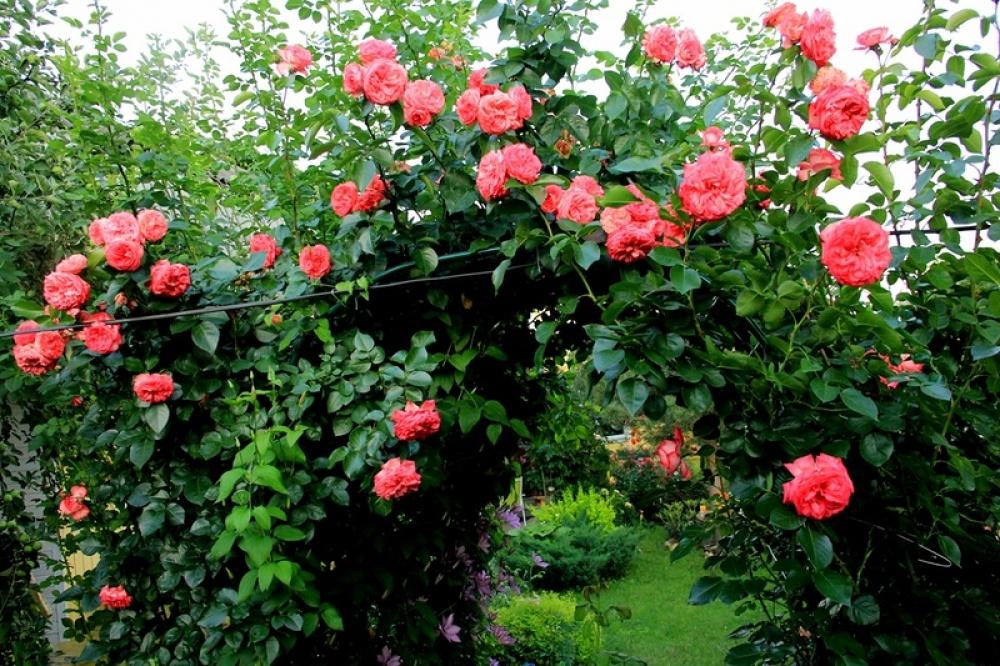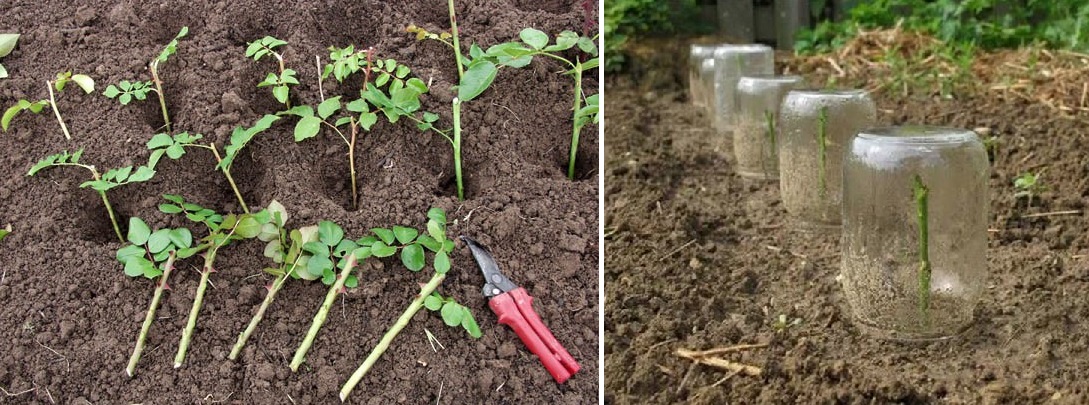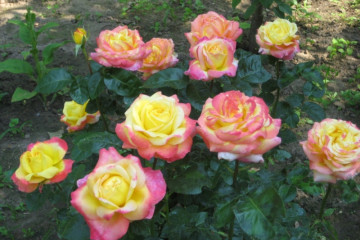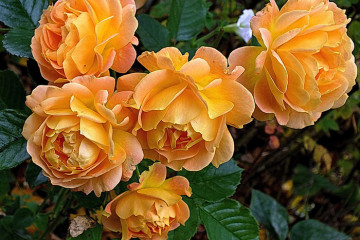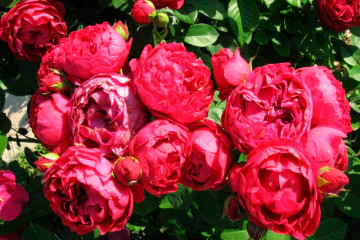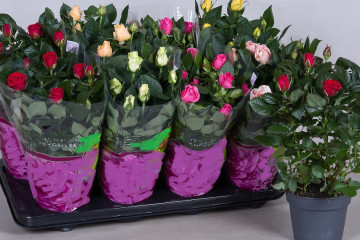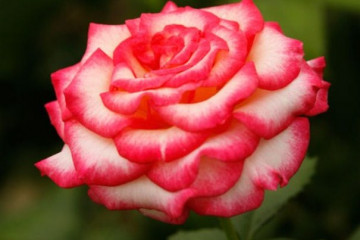Rosa Antik (Antike 89) - what is this climbing variety
Content:
Climber roses are in great demand when creating unique picturesque compositions in garden plots and in recreation areas. Luxurious, profusely blooming whips allow you to transform even the most ordinary-looking corners. Rosa Antik is the best suited for these purposes, which is why it has been very popular with gardeners all over the world for more than 30 years.
Description and characteristics of the variety
Climbing rose Antike, due to its varietal characteristics, is rightfully considered one of the best climber roses on the market today. This variety was bred by German breeders of the Cordes company in 1988 on the basis of the English park variety Grand Hotel and is presented at exhibitions as Antique, Antike 89, KORdalen.
The bushes of the vine culture, growing densely, reach a height of 2-3 meters and a width of up to 200 cm. The root system is powerful, deeply penetrating into the soil.
The lashes are straight and quite flexible, but stiff, covered with medium-sized spines. Large dense foliage has a dark green color and glossy sheen.
Flowering is abundant, long-lasting and repeated. 3-5 inflorescences are formed on the shoots. The buds are large, cupped. Flowers, consisting of 70-80 rounded petals, when fully blossomed, reach 12-13 cm in diameter.
The edges of the petals fold outward to create a lace effect. The color of the flowers is smoothly changing from creamy white at the middle to deep crimson closer to the tips of the petals. The aroma is light and delicate, with fruity notes.
According to the description, the climbing rose Antik 89 prefers fertile soils in which moisture does not accumulate.
It is resistant to fungi and winter hardiness. It recovers quickly even after very cold winters.
The disadvantages of the variety include the slow growth of shoots, which is why you can see the plant in all its glory only 3-4 years after planting in open ground.
Antique can be considered the best choice for vertical landscaping, it will decorate any wall or fence. However, due to the thickness of the shoots and their rigidity, it is not suitable for creating arched structures. To give the bush the desired shape, the branches are hung on a fan-shaped support, guiding them vertically and horizontally. Periodic pruning of shoots allows you to grow Antike 89 rose with a scrub.
Growing a flower
Most suitable for climbers are areas open from the south, south-east or south-west side, on which daylight hours lasts at least 6 hours.
The soil should be fertile, loose, optimally - loam with a slightly acidic reaction. Antique should not be transplanted too often so as not to injure the roots. Planting in the ground is carried out in the spring, in April, or in the fall, when there are several weeks in stock before frost.
The process is as follows:
- In the selected place, the soil is dug up. If the soil at the planting site is unsuitable, then it is better to completely replace it by making the hole 2 times deeper.
- A pit is prepared with a depth of 0.5 meters.
- When planting in clay soil, a drainage layer of 15-20 cm is formed, with sandy soil, up to 10 cm of clay soil is poured.
- The seedling is examined, the roots are shortened, removing the non-viable completely.
- The roots are spread inside the pit and covered with earth.
- The plant is watered abundantly and the settled soil is poured.
- The area around the bush is mulched.
Plant care
Climbing roses are quite unpretentious. Young plants of the first year of life should be watered often, but from the second season the number of waterings is reduced, making them more abundant. Top dressing of roses is carried out 4-5 times during the growing season, using organic fertilizers and minerals.
Pruning is carried out in the spring, cutting off the dried lashes to ground level. The optimal ratio of branches is 3-7 main and 1-3 young shoots of the last year. The lashes are shortened by a third, and the side shoots are shortened to the 3rd bud.
Antique Rose bushes grown in cold regions are recommended to be covered for the winter. To do this, you need to lay the lashes on a substrate of straw, covered with a non-woven material in 2 layers. In the spring, the shelter is removed gradually, allowing the plant to get used to the open sunlight.
Blooming rose
Climbing rose Antik - re-blooming. The first lush and rich flowering, subject to the conditions of correct pruning, is followed by a second one.
The flowers of the second wave are no less bright than the first ones. The buds continue to form until the autumn frosts. The flowering of the first year may not be too lush, but with proper care, the rose will become more attractive from year to year.
Flower propagation
Reproduction of rose climbers can be carried out in four different ways: sowing seeds, planting layers, rooting cuttings and grafting on rose hips. Moreover, grafting is much easier and gives better results.
For this:
- in the period from June to August, cuttings with 2 internodes or more are cut from fading or flowering shoots (the lower cut is under the bud at an angle of 45 °, the upper cut is straight, at a distance of 5 cm from the bud);
- the lower leaves are cut off from the cutting, the upper ones are cut to the middle;
- cuttings are buried 1 cm in sand or a mixture of sand and earth in a suitable illuminated area, protected from direct sunlight;
- cover each stalk with a glass jar;
- watering is carried out without removing the jars, as the soil dries out.
By the winter period, the cuttings are unlikely to have time to root well, so in the fall they are carefully dug up and transferred to storage in a cool room, sprinkling the roots with wet sand. Leaving cuttings for wintering in the ground is possible only if it is very well insulated.
After winter, the seedlings are taken out of storage and planted in a greenhouse. It is allowed to open them only after a month, having previously gradually accustomed them to the sun's rays and open air. Transplantation to a permanent place can only be carried out next spring.
Diseases, pests and ways to control them
Spider mites, aphids, leafworms, thrips, rose sawfly - a list of the most active parasites in relation to the Antique rose 89. You can get rid of them with the help of insecticides or folk remedies (for example, soap solution or tobacco infusion).
Among the diseases, the most dangerous can be considered gray rot and powdery mildew. Irrigation of the plant with a solution of iron sulfate (3%), copper sulfate (2%) or Bordeaux liquid (3%) helps to cope with them.
Of course, growing an Antique rose will require a certain investment of time and effort. But compliance with the recommendations given will greatly simplify the matter and allow you to admire the abundant flowering of this variety with a fabulous color.

